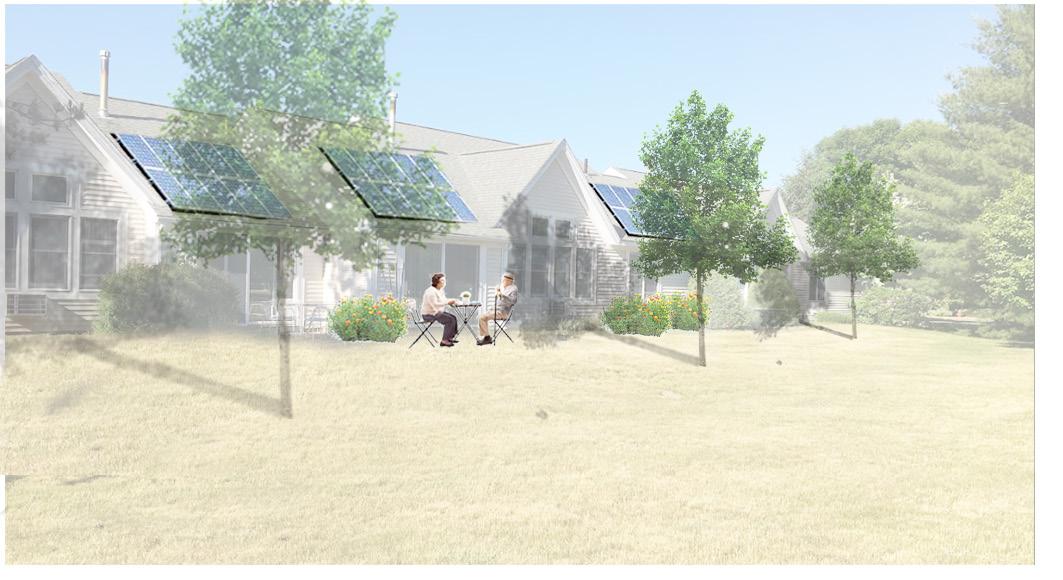
3 minute read
Design Direction: Planting For Energy Efficiency
Design Direction: Plantings for Energy Efficiency
Trees are natural temperature regulators and can reduce the need for both winter heating and summer cooling in buildings. Trees cast shade, protecting surfaces from the sun, and cool the air around them through the process of evapotranspiration. The combination of shading and evapotranspiration leads to dramatic reductions in the need for mechanical cooling systems. Various studies have measured that suburbs with mature trees are 4 to 6 degrees Fahrenheit cooler than suburban areas without significant tree cover (EPA). This reduces the need for cooling , and creates safer conditions to be outside. Planting trees anywhere near a home will contribute some summer cooling effect; however, to get the most shade on a building it is best to plant on the southern side. Deciduous trees should always be used for this purpose because they provide cooling during the summer when it is most needed but allow sunlight through the canopy in the winter when heating is needed. Evergreen trees, if planted to the south of buildings, can actually increase winter heating needs.
Tree planting in a way that blocks rooftop solar panels would be counterproductive. If planting next to a townhome that has or is suitable for solar panels, plant a species that grows to a maximum of 10 feet or for every foot over 10 place it an extra foot away from the home. For example a 30-foot tree could be planted 20 feet away from a structure with solar panels or a 50-foot tree planted 40 feet away. Planting to the west of structures also provides valuable cooling as it shades the home during the afternoon, and since it would not interfere with solar panels, larger species can be used.
Trees can also reduce energy needs for winter heating by partially blocking cold winter winds from hitting the walls of a building, reducing the loss of thermal energy. Since winter winds in this region generally travel from the north or northwest to south or southeast, it is best to plant trees to the north or northwest of a home. Evergreen trees with a dense branching structure are most effective at protecting buildings from cold winds. When these trees are positioned to the northern side of a building, blocking solar panels is not a concern.
In this rendering birch (Betula nigra) trees are aligned next to the gables and placed farther from the structures to minimize shading. This design of three birch trees would reduce summer cooling costs by an estimated $74 each year once the trees reach maturity. The cooling effect would also improve the efficiency of rooftop PV panels. Energy savings are estimated using the US Forest Service iTree tool.
This combination of Eastern red cedar and rhododendron on the north side of two townhomes preserves views into the meadow. Once fully grown, these plants would reduce annual heating costs by an estimated total of $79 each year. Energy savings are estimated using the US Forest Service iTree tool.


This row of Eastern red cedars on the northern side of two townhomes would block views into the meadow, but it would provide excellent protection from cold winds, reducing heating costs by an estimated $137 each year once trees reach maturity. Energy savings are estimated using the US Forest Service iTree tool.
Common Name
Eastern redbud red mulberry serviceberry musclewood river birch tulip tree sweet gum red maple American holly Eastern red cedar red spruce baslam fir mountain laurel rhododendron
Latin Name
Cercis canadensis Morus rubra Allegheny laevis Carpus carolinia Betula nigra Liriodendron tulipeferia Liquidambar styracifula Acer rubrum Ilex opaca Juniperus virginiana Picea rubens Abies balsamesa Kalmia latifolia Rhododendron spp.
Type
deciduous deciduous deciduous deciduous deciduous deciduous deciduous deciduous evergreen evergreen evergreen evergreen evergreen evergreen
Height at Maturity
12-25’ 15-30’ 15-25’ 20-35’ 25-45’ 60-90’ 60-90’ 35-50’ 12-30’ 15-30’ 30-60’ 35-60’ 4-10’ 5-15’










